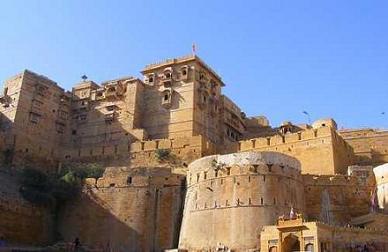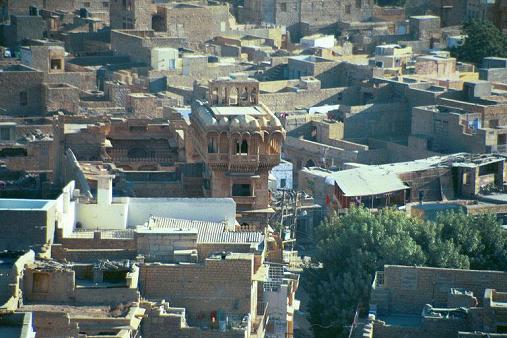
History of jaisalmer jaisalmer city view The majority of any inhabitants of jaisalmer are Bhatti Rajputs, who take their name from an ancestor named Bhatti, renowned as a warrior when the tribe were located in the Punjab. Shortly after this the clan was driven southwards, and found a refuge in the Indian desert, which was henceforth its home. This area was part of Gurjar Pratihara empire and till 11 centuary was ruled by a powerful Bargujar King. Deoraj, a famous prince of the Bhati family, is esteemed the real founder of the jaisalmer dynasty, and with him the title of rawal commenced. In 1156 Rawal Jaiswal, the sixth in succession from Deoraj, founded the fort and city of jaisalmer, and made it his capital as he moved from his former capital at Lodhruva (which is situated about 15 km to the north-west of jaisalmer). In 1293, the Bhattis so enraged the emperor Ala-ud-din Khilji that his army captured and sacked the fort and city of jaisalmer, so that for some time it was quite deserted. Some Bhatti's migrated to Talwandi, now Nankana Sahib in Distt. Nankana Sahib (Punjab, Pakistan) and others settled in Larkana (in Sind, Pakistan)under the name of Bhutto. In Nankana Sahib, the Bhatti Clan can be traced from the lineage of Rai Bhoe and Rai Bular Bhatti. After this there is nothing to record until the time of Rawal Sahal Singh, whose reign marks an epoch in Bhatti history in that he acknowledged the supremacy of the Mughal emperor Shah Jahan. The jaisalmer princes had now arrived at the height of their power, but from this time till the accession of Rawal Mulraj in 1762 the fortunes of the state rapidly declined, and most of its outlying provinces were lost. In 1818 Mulraj entered into political relations with the British. Maharawal Salivahan, born in 1887, succeeded to the chiefship in 1891. The Maharajas of jaisalmer trace their lineage back to Jaitsimha, a ruler of the Bhatti Rajput clan. The major opponents of the Bhati Rajputs were the powerful Rathor clans of Jodhpur and Bikaner. They used to fight battles for the possession of forts, waterholes or cattle. jaisalmer was positioned strategically and was a halting point along a traditional trade route traversed by the camel caravans of Indian and Asian merchants. The route linked India to Central Asia, Egypt, Arabia, Persia, Africa and the West.  Flag of the princely state of jaisalmerDuring the Islamic invasion of India, jaisalmer escaped direct Muslim conquest due to its geographical situation in the desert region. The Rawals of jaisalmer agreed to pay an annual tribute to the Delhi Sultans. The first siege of jaisalmer occurred during the reign of Alauddin Khilji. It was provoked by Bhatis' raid on a caravan filled with treasure. According to local ballads, the Bhatis defended the fort for seven years until the enemy army forced beached the ramparts. Bhatis, facing certain defeat, proclaimed the rite of jauhar. Later, Sultan Ferozshah also sieged jaisalmer after the rulers of jaisalmer raided his camp at Anasagar lake near Ajmer. The siege led to another jauhar. Jaitsimha's son Duda perished in the attack. Duda's descendants ruled over jaisalmer for about two centuries. Duda's descendant Lunakarna had a fight with Humayun when the latter passed through jaisalmer en route to Ajmer. Mughal emperor Akbar was married to one of the jaisalmer princesses. Later, jaisalmer was ruled by a noble called Sabala Simha, who won the patronage of the Mughal emperor Shah Jahan for services rendered in his Peshawar campaign. Facade of a mansion in jaisalmerjaisalmer was one of the last states to sign a treaty with the British. During the British Raj, jaisalmer was the seat of a princely state of the same name, ruled by the Bhati clan of rajputs. The present descendant is Brijraj Singh. Though the city is under the governance of the Government of India, a lot of welfare work is carried out by him and his family. The Royal Family still commands a lot of respect from the people. Traditionally, the main source of income was the levies on the caravans. However, the glory of jaisalmer faded when Bombay emerged as a port and the sea trade replaced the traditional land routes. The partition of India in 1947 lead to closing of all the trade routes on the Indo-Pak border and rendered jaisalmer a drought-prone desert backwater on the international border. Ironically, skirmishes between India and Pakistan gave jaisalmer a strategic importance and made it serviceable as an army supply depot. Later, the Rajasthan Canal served to revive the surrounding desert areas. Roads and railroads were then built, knitting the hitherto remote town with the rest of Rajasthan. Later, the Government of Rajasthan decided to promote jaisalmer as a tourist destination. Courage, valor and regal determination turned jaisalmer into one of the most powerful Rajasthan states that survived inspite of being a waterless land. In fact entire jaisalmer had just one water source in the olden days and that was the manmade Gadi Sagar Tank. The history of jaisalmer is marked by royal intrigues, wars and desert romances. jaisalmer lost its importance as an important caravanserai after the development of Mumbai ports. jaisalmer was a lost chapter till two crucial Indo-Pak wars that reinforced jaisalmer's importance as a border state. |

